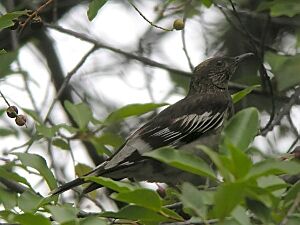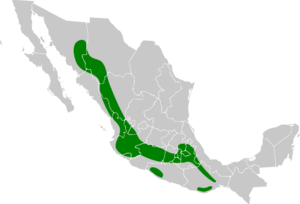Aztec thrush facts for kids
Quick facts for kids Aztec thrush |
|
|---|---|
 |
|
| Digiscoped in Madera Canyon, Arizona | |
| Conservation status | |
| Scientific classification | |
| Genus: |
Ridgwayia
|
| Species: |
pinicola
|
 |
|
| Synonyms | |
|
Turdus pinicola |
|
The Aztec thrush (scientific name: Ridgwayia pinicola) is a type of bird in the thrush family. These birds mostly live in Mexico. Sometimes, a few Aztec thrushes might wander into the United States. They like to live in montane forests, which are forests found in mountains. Scientists consider them a "least concern" species, meaning they are not currently in danger.
Contents
What is the Aztec Thrush?
The Aztec thrush was first described in 1859 by a scientist named Philip Sclater. He called it Turdus pinicola. Later, in 1882, another scientist, Leonhard Stejneger, decided this bird needed its own special group, or genus. He named this group Ridgwayia, to honor an ornithologist (a bird scientist) named Robert Ridgway.
What Does the Aztec Thrush Look Like?
The Aztec thrush is about 21.5 to 24 centimeters (8.5 to 9.5 inches) long. It weighs between 67 and 88 grams (about 2.4 to 3.1 ounces).
Male Aztec thrushes have a dark brown "hood" on their head and neck. Their back and wings are also dark brown. Some parts of their wings have white edges. Their tail is black or dark brown with whitish-grey tips. The chest is dark brown, and the rest of their belly is white. Their beak is dark brown, and their legs are pale pink.
Female Aztec thrushes look a bit different. They don't have the dark hood and are generally paler. Young birds are blackish with golden-brown spots on their head and back.
Where Do Aztec Thrushes Live?
These birds are mainly found in the mountains of Mexico. They live at high altitudes, usually between 1,800 and 3,500 meters (about 5,900 to 11,500 feet) above sea level. Their favorite places are ravines in pine forests or forests with both pine and oak trees.
Sometimes, an Aztec thrush might fly far from its usual home. These "vagrants" have been seen in places like western Texas and southeastern Arizona in the United States. The first time one was seen in the U.S. was in 1977, in Big Bend National Park in Texas.
How Do Aztec Thrushes Behave?
Aztec thrushes often hang out in small groups. Sometimes, they even join other types of birds to look for food together. They usually search for food on the ground, hidden in thick plants. They eat berries and insects. You might see them tilting their head while they are eating.
Their calls sound like wheeerr, prreep, whein, and sweee-uh. Their song is a mix of these calls and other sounds. In the southern parts of Mexico, they build their nests and lay eggs from May to June. Their nest is shaped like a cup and is made from grass and moss. The eggs are a pretty pale blue color.
Is the Aztec Thrush in Danger?
There are likely fewer than 50,000 Aztec thrushes in the world. Their numbers might be going down because their forest homes are shrinking. However, this decline is not happening fast enough for them to be considered an endangered species right now. Because of this, the IUCN Red List says the Aztec thrush is a "least concern" species. This means they are not currently at high risk of disappearing.


